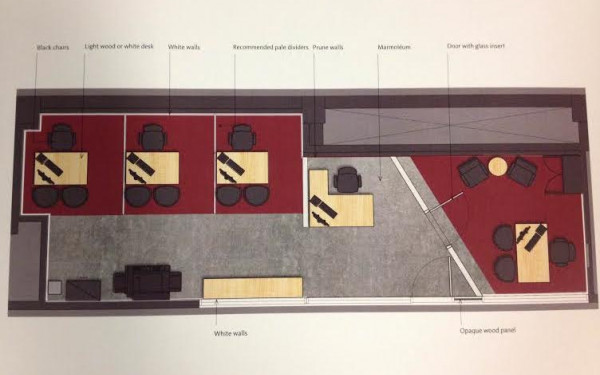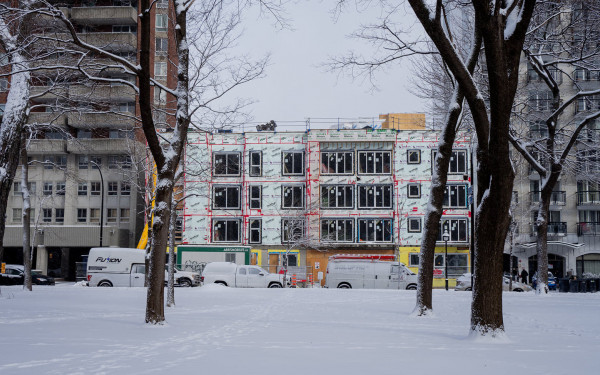Deconstructing ConU
New Round of Renos Clogs Up Concordia Buildings
Inside and out, Concordia University is in a seemingly perpetual state of construction.
This week is no different, as crews began a new phase of the decade-long Quartier Concordia initiative on Monday by shutting down and tearing up de Maisonneuve Blvd. W. from Bishop St. to Guy St.
The section will be closed for the next three weeks for leveling and re-asphalting of the busy road. Although this stretch of de Maisonneuve has been in fluctuating states of disrepair for the better part of a year, not all of it has been on Concordia’s hands.
“Our part is done now,” said Concordia’s Project Director Jean Pelland, referring to the sidewalks that run along the front entrance to the Hall Building. “We paid the city to do our part, and it’s done. Really the rest is running a bit late, but they’re doing their best.”
That part of the project also included replacing the membranes and waterproofing the Hall and the Library Building.
All told, the city project rings in at $2.7 million, of which Concordia paid $450,000 to have their part completed.
In 2003, the city launched Quartier Concordia, a massive initiative in conjunction with the university and architectural firm Groupe Cardinal Hardy that is aimed at redesigning and reclaiming the Sir George Williams campus.
The Quartier is bordered to the north and south by Sherbrooke St. W. and René-Lévesque Blvd., and to the east and west by Bishop St. and Guy St.
The total cost of the initiative has been estimated at nearly half a billion dollars, and has been responsible for the creation of Norman Bethune Square and the underground tunnels that run between Concordia’s buildings, among other projects.
A new phase of the plan is set to begin in the spring on Bishop St. and Mackay St., although the project’s budget has yet to be approved.
Navigating the Blue Fence
The timing of all this concrete smashing is less than ideal, however, as thousands of students flood the campus in time for the beginning of the semester.
The university, however, is taking some steps towards lessening the blow of what could be a hectic and confusing first week of classes for students unfamiliar with Quartier Concordia.
Organized by the Dean of Students office, a group of yellow-shirted volunteers—appropriately named the Welcome Crew—are out on the streets guiding students through these awkward times.
The Welcome Crew is in its third year, but this time around has been a bit different.
“In the first week, we got a lot of questions because a lot of people were confused about the construction,” said Welcome Crew volunteer Zoya de Frias Lakhany.
“Even second- and third-year students were confused. In the second week it’s been less, and we’re getting more questions like, ‘Where can I get my student ID,’ and, ‘Where can I see an advisor?’”
University spokesperson Chris Mota suggested that students looking to avoid the chaos on the street level head underground.
“The university didn’t build tunnels for the sake of building tunnels,” said Mota. “That’s one of the main reasons they were built—to move pedestrian traffic underground […] The more people we can move underground, the better.”
The Escalator Project
In the winter of 2010, Concordia embarked on a long-awaited project to replace the decrepit escalators that have plagued the Hall Building since what seems like time immemorial.
“The escalator project has been a sort of running gag,” said Jean Pelland, explaining the long and arduous process the university had to undergo to obtain a government grant to begin the project.
“It’s particularly difficult in an occupied building to forecast a budget like this,” he said. “We never know what problems we might discover, especially when there is asbestos.”
The escalator removal project was budgeted at $14.7 million and includes four phases comprising the replacement of 17 escalators.
Though the university community has been inconvenienced by the gutting of one of the oldest and most-used building on campus, Pelland said that the project is exceeding expectations.
“We are below budget and ahead of schedule,” said Pelland. “If we want to teach a class on how to run and manage a project, this is the one we’ll have to share with the students.”
According to Pelland, the project is currently four per cent under budget, and three of its four phases have been completed. The fourth phase, which includes the escalators between the sixth and seventh floors, is expected to be completed by December.
“The original schedule was to complete the entire project by March 2013,” said Pelland. “We’re almost three months ahead of schedule. Why? We overlapped phases three and four this summer.”
With the final escalators in place, Pelland says all that’s left will be touch-ups to the granite
in the lobby and finishing the ceilings around some of the escalators.

3_900_600_90.jpg)
_600_832_s.png)



3_600_375_90_s_c1.jpg)
